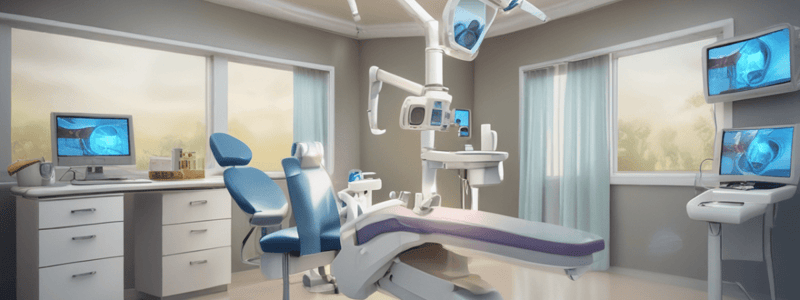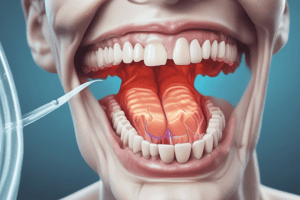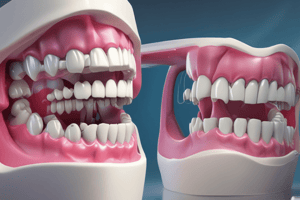Podcast
Questions and Answers
What is the term for a well-defined localized radiopaque area surrounded by a radiolucent uniform halo?
What is the term for a well-defined localized radiopaque area surrounded by a radiolucent uniform halo?
- Multifocal confluent pattern
- Target lesion (correct)
- Focal opacity
- Ground-glass opacity
What type of radiolucent lesion appears as a granular or pebbled texture?
What type of radiolucent lesion appears as a granular or pebbled texture?
- Mixed lucent-opaque lesion
- Focal opacity
- Ground-glass opacity (correct)
- Multifocal confluent pattern
What is the term for a radiopacity that exhibits both lucent and opaque components?
What is the term for a radiopacity that exhibits both lucent and opaque components?
- Mixed lucent-opaque lesion (correct)
- Ground-glass opacity
- Multifocal confluent pattern
- Focal opacity
What is the term for a radiolucent area with a central opaque fleck?
What is the term for a radiolucent area with a central opaque fleck?
What type of radiopacity appears as multiple radiopacities that overlap or flow together?
What type of radiopacity appears as multiple radiopacities that overlap or flow together?
What is the term for a well-defined radiopaque area located in soft tissue?
What is the term for a well-defined radiopaque area located in soft tissue?
What is the term for a radiolucent lesion that appears in an edentulous area?
What is the term for a radiolucent lesion that appears in an edentulous area?
What type of radiopacity has an irregular or poorly defined pattern?
What type of radiopacity has an irregular or poorly defined pattern?
What is the term for a radiolucent lesion that appears between the roots of adjacent teeth?
What is the term for a radiolucent lesion that appears between the roots of adjacent teeth?
What is the term for a radiolucent lesion that surrounds the crown of a tooth?
What is the term for a radiolucent lesion that surrounds the crown of a tooth?
What is the term used to describe the outer layer or border of radiolucency?
What is the term used to describe the outer layer or border of radiolucency?
What type of radiolucent lesion has a thin, well-defined radiopaque rim of bone at the periphery?
What type of radiolucent lesion has a thin, well-defined radiopaque rim of bone at the periphery?
What is the characteristic of a multilocular radiolucent lesion?
What is the characteristic of a multilocular radiolucent lesion?
What is the term used to describe a radiolucent lesion with one radiolucent compartment?
What is the term used to describe a radiolucent lesion with one radiolucent compartment?
What is the characteristic of a unilocular lesion with non-corticated border?
What is the characteristic of a unilocular lesion with non-corticated border?
What is the importance of location in radiolucent lesions?
What is the importance of location in radiolucent lesions?
What is the term for the portion of the radiograph that appears dark or black?
What is the term for the portion of the radiograph that appears dark or black?
What is the term used to describe the area around the apex of the root?
What is the term used to describe the area around the apex of the root?
What type of radiolucent lesion causes expansion of the jaw in buccal and lingual sides?
What type of radiolucent lesion causes expansion of the jaw in buccal and lingual sides?
Which of the following characteristics is NOT important for lesion diagnosis on a radiograph?
Which of the following characteristics is NOT important for lesion diagnosis on a radiograph?
What is the characteristic of a radiolucent lesion in the periapical location?
What is the characteristic of a radiolucent lesion in the periapical location?
What is the term for the portion of the image that appears white or light on a radiograph?
What is the term for the portion of the image that appears white or light on a radiograph?
What is the term used to describe a radiolucent lesion with multiple radiolucent compartments and well-defined corticated margins?
What is the term used to describe a radiolucent lesion with multiple radiolucent compartments and well-defined corticated margins?
What is the term for a radiographic image that has both radiolucent and radiopaque components?
What is the term for a radiographic image that has both radiolucent and radiopaque components?
Which of the following is an example of a radiolucent area on a radiograph?
Which of the following is an example of a radiolucent area on a radiograph?
What is the term for a radiographic image that has multiple areas of opacity?
What is the term for a radiographic image that has multiple areas of opacity?
Which of the following is NOT a characteristic of a radiolucent area on a radiograph?
Which of the following is NOT a characteristic of a radiolucent area on a radiograph?
What is the term for a radiographic image that has a hazy or cloudy appearance?
What is the term for a radiographic image that has a hazy or cloudy appearance?
Which of the following is an example of a radiopaque area on a radiograph?
Which of the following is an example of a radiopaque area on a radiograph?
What is the term for a radiographic image that has a clear and distinct border?
What is the term for a radiographic image that has a clear and distinct border?
What is the Benign Cementoblastoma typically associated with?
What is the Benign Cementoblastoma typically associated with?
What is the characteristic of the lesion in the third stage of Benign Cementoblastoma?
What is the characteristic of the lesion in the third stage of Benign Cementoblastoma?
What is the prognosis of Benign Cementoblastoma after extraction of the involved tooth and excision of the mass?
What is the prognosis of Benign Cementoblastoma after extraction of the involved tooth and excision of the mass?
In which decade of life does Benign Cementoblastoma typically occur?
In which decade of life does Benign Cementoblastoma typically occur?
What is the most likely diagnosis for the 33-year-old woman with a swelling on the palate?
What is the most likely diagnosis for the 33-year-old woman with a swelling on the palate?
What is the effect of the lesion on the involved tooth?
What is the effect of the lesion on the involved tooth?
Where is the tumor most likely to occur?
Where is the tumor most likely to occur?
What is the characteristic radiographic appearance of odontogenic myxoma?
What is the characteristic radiographic appearance of odontogenic myxoma?
What is the age range for the occurrence of odontogenic myxoma?
What is the age range for the occurrence of odontogenic myxoma?
What is the likely consequence of a large odontogenic myxoma?
What is the likely consequence of a large odontogenic myxoma?
What is the typical location of a torus palatinus?
What is the typical location of a torus palatinus?
What is the most common location of ameloblastoma?
What is the most common location of ameloblastoma?
What is the characteristic of a torus palatinus on a radiograph?
What is the characteristic of a torus palatinus on a radiograph?
What is the age range when most cases of ameloblastoma occur?
What is the age range when most cases of ameloblastoma occur?
What type of tumor is an osteoblastoma?
What type of tumor is an osteoblastoma?
What is the characteristic of a unicystic variant of ameloblastoma?
What is the characteristic of a unicystic variant of ameloblastoma?
What is the difference between an osteoblastoma and an osteoid osteoma?
What is the difference between an osteoblastoma and an osteoid osteoma?
What is the origin of ameloblastoma?
What is the origin of ameloblastoma?
What type of tumor is a chondroma?
What type of tumor is a chondroma?
What is the characteristic of ameloblastoma?
What is the characteristic of ameloblastoma?
What is a characteristic feature of an ameloblastoma on a radiograph?
What is a characteristic feature of an ameloblastoma on a radiograph?
What is the recurrence rate of ameloblastoma after surgical treatment?
What is the recurrence rate of ameloblastoma after surgical treatment?
What is the typical age group affected by calcifying epithelial odontogenic tumor?
What is the typical age group affected by calcifying epithelial odontogenic tumor?
What is the common location of ameloblastoma?
What is the common location of ameloblastoma?
What is the effect of an ameloblastoma on the surrounding bone?
What is the effect of an ameloblastoma on the surrounding bone?
What is the characteristic arrangement of dental tissues in a compound odontoma?
What is the characteristic arrangement of dental tissues in a compound odontoma?
What is the characteristic radiographic appearance of a calcified epithelial odontogenic tumor?
What is the characteristic radiographic appearance of a calcified epithelial odontogenic tumor?
In which part of the jaw is a complex odontoma more likely to occur?
In which part of the jaw is a complex odontoma more likely to occur?
What is the term for an odontogenic tumor of mixed tissue origin with epithelial and mesenchymal cells?
What is the term for an odontogenic tumor of mixed tissue origin with epithelial and mesenchymal cells?
What is the characteristic radiographic appearance of an odontogenic myxoma?
What is the characteristic radiographic appearance of an odontogenic myxoma?
What is the characteristic of a compound odontoma?
What is the characteristic of a compound odontoma?
What is the most likely diagnosis for a 33-year-old woman with a swelling on palate and a multilocular radiolucency involving the palate on a maxillary occlusal radiograph?
What is the most likely diagnosis for a 33-year-old woman with a swelling on palate and a multilocular radiolucency involving the palate on a maxillary occlusal radiograph?
What is the characteristic of the tissue in an odontogenic myxoma?
What is the characteristic of the tissue in an odontogenic myxoma?
What is the term for an odontogenic tumor that exhibits complete differentiation to ameloblasts and odontoblasts, forming abnormal enamel and dentin?
What is the term for an odontogenic tumor that exhibits complete differentiation to ameloblasts and odontoblasts, forming abnormal enamel and dentin?
What is the origin of an odontogenic myxoma?
What is the origin of an odontogenic myxoma?
What type of tumor is characterized by a haphazard arrangement of dental tissues?
What type of tumor is characterized by a haphazard arrangement of dental tissues?
What is the characteristic of the radiopaque mass in a complex odontoma?
What is the characteristic of the radiopaque mass in a complex odontoma?
What is the association between a complex odontoma and an unerupted tooth?
What is the association between a complex odontoma and an unerupted tooth?
What is the term for a complex odontoma that has some organized dental tissues?
What is the term for a complex odontoma that has some organized dental tissues?
What is the characteristic of an odontogenic myxoma in terms of its growth?
What is the characteristic of an odontogenic myxoma in terms of its growth?
Flashcards
Radiographic Interpretation
Radiographic Interpretation
Radiographic interpretation focuses on analyzing the radiographic image to identify abnormalities and potential pathologies.
Interpretation vs. Diagnosis
Interpretation vs. Diagnosis
Radiographic interpretation involves identifying features on a radiograph, while diagnosis is the final conclusion based on all available information, including clinical and radiographic findings.
Radiographic Terminology
Radiographic Terminology
Terms like radiolucent, radiopaque, unilocular, and multilocular are used to describe the appearance of structures on radiographs, aiding interpretation.
Radiolucent Lesions
Radiolucent Lesions
Signup and view all the flashcards
Radiopaque Lesions
Radiopaque Lesions
Signup and view all the flashcards
Unilocular Radiolucent Lesion
Unilocular Radiolucent Lesion
Signup and view all the flashcards
Unilocular Lesion with Corticated Border
Unilocular Lesion with Corticated Border
Signup and view all the flashcards
Unilocular Lesion with Non-Corticated Border
Unilocular Lesion with Non-Corticated Border
Signup and view all the flashcards
Multilocular Radiolucent Lesion
Multilocular Radiolucent Lesion
Signup and view all the flashcards
Periapical Location
Periapical Location
Signup and view all the flashcards
Inter-radicular Location
Inter-radicular Location
Signup and view all the flashcards
Edentulous Zone
Edentulous Zone
Signup and view all the flashcards
Pericoronal Location
Pericoronal Location
Signup and view all the flashcards
Size of Lesions
Size of Lesions
Signup and view all the flashcards
Shape of Lesions
Shape of Lesions
Signup and view all the flashcards
Effect on Surrounding Structures
Effect on Surrounding Structures
Signup and view all the flashcards
Radio-Density of Lesions
Radio-Density of Lesions
Signup and view all the flashcards
Ameloblastoma
Ameloblastoma
Signup and view all the flashcards
Calcifying Epithelial Odontogenic Tumor
Calcifying Epithelial Odontogenic Tumor
Signup and view all the flashcards
Adenomatoid Odontogenic Tumor
Adenomatoid Odontogenic Tumor
Signup and view all the flashcards
Odontoma
Odontoma
Signup and view all the flashcards
Ameloblastic Fibroma
Ameloblastic Fibroma
Signup and view all the flashcards
Ameloblastic Fibro-Odontoma
Ameloblastic Fibro-Odontoma
Signup and view all the flashcards
Odontogenic Myxoma
Odontogenic Myxoma
Signup and view all the flashcards
Benign Cementoblastoma
Benign Cementoblastoma
Signup and view all the flashcards
Torus Palatinus
Torus Palatinus
Signup and view all the flashcards
Torus Mandibularis
Torus Mandibularis
Signup and view all the flashcards
Odontogenic Myxoma
Odontogenic Myxoma
Signup and view all the flashcards
Benign Cementoblastoma
Benign Cementoblastoma
Signup and view all the flashcards
Study Notes
Radiographic Interpretation
- Importance of interpretation of radiographic image
- Difference between interpretation and diagnosis
- Understanding different radiographic terminologies
Radiolucent and Radiopaque Lesions
- Radiolucent lesions:
- Appear dark or black on film
- Examples: air space, soft tissues, dental pulp, periodontal ligament space
- Radiopaque lesions:
- Appear white or light on film
- Examples: metal restoration, enamel, dentin, bone
Terms Used to Describe Radiolucent Lesions
- Unilocular radiolucent lesion:
- Single radiolucent compartment
- Unilocular lesion with corticated border:
- Radiolucent compartment with a thin, well-demarcated radiopaque rim of bone
- Unilocular lesion with non-corticated border:
- Radiolucent compartment without a radiopaque rim of bone
- Multilocular radiolucent lesion:
- Multiple radiolucent compartments
- Exhibit well-defined corticated margins
Location of Lesions
- Periapical location:
- Area around the apex of the root
- Inter-radicular location:
- Area between the roots of adjacent teeth
- Edentulous zone:
- Area without teeth
- Pericoronal location:
- Area around the crown of an impacted tooth
Size and Shape of Lesions
- Size: varies from millimeter to several centimeters in diameter
- Shape:
- Unilocular: round, oval, or scalloped
- Multilocular: irregular or honeycomb appearance
Radiographic Features of Lesions
- Effect on adjacent surrounding structure:
- Teeth: resorption, displacement, delayed eruption, disrupted development
- Bone: expansion, alteration in size of pulp chamber, hypercementosis
- Relative radio-density and internal structure:
- Uniformly radiolucent
- Mixed radiopaque
Benign and Malignant Lesions of the Jaws
- Benign odontogenic tumors:
- Ameloblastoma
- Calcifying epithelial odontogenic tumor
- Adenomatoid odontogenic tumor
- Odontoma
- Ameloblastic fibroma
- Ameloblastic fibro-odontoma
- Odontogenic myxoma
- Benign cementoblastoma
- Malignant lesions of the jaws:
- Not discussed in this text
Specific Lesions
- Torus palatinus:
- Bony protuberance in the middle third of the hard palate
- Can vary in size and shape
- Can cause cortical expansion
- Torus mandibularis:
- Bony growth on the lingual surface of the mandible
- Can cause cortical expansion
- Odontogenic myxoma:
- Multilocular radiolucency with angular septa
- Can cause cortical expansion and facial asymmetry
- Benign cementoblastoma:
- Radiopaque mass attached to the root of a tooth
- Can cause cortical expansion and facial asymmetry
Studying That Suits You
Use AI to generate personalized quizzes and flashcards to suit your learning preferences.





